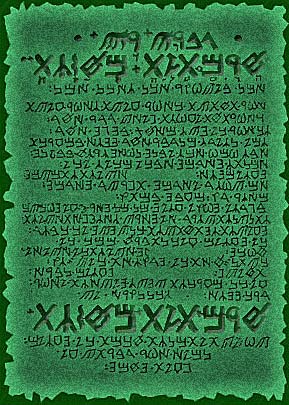The Emerald Tablet, also known as Smaragdine Table, Tabula Smaragdina, or The Secret of Hermes, is a text purporting to reveal the secret of the primordial substance and its transmutations. It claims to be the work of Hermes Trismegistus ("Hermes the Thrice-Greatest"), a legendary Hellenistic combination of the Greek god Hermes and the Egyptian god Thoth.
The Emerald Tablet is an ancient artifact whose current whereabouts are unknown. What was written on it is the foundation of Hermetic Philosophy and perhaps it contains a recipe for preparing the philosopher’s stone which can turn metals into gold. Or else it symbolizes the spiritual equivalent, purifying the soul. Versions of its text became known to the Christian world after the fourteenth century through Arabic translations.
The physical Emerald Tablet was described as a rectangular object of exquisite workmanship, with its sacred message written in bas-relief or carved out, using an alphabet similar to Phoenician. Supposedly this tablet is made of emerald, a gem cherished by the ancients. But since large quality emeralds from the old world (if it was from the old world or from earth even) probably never existed and since there is confusion over what was, and what was called an emerald in the old world, it was perhaps more likely another green crystal, jasper or jade. It may have been simply green colored glass.
Most consider the writings on the Emerald Tablet to be one of the earliest of all extant Western alchemical works, originating from pre-Greek sources. In mystical circles it is still popular with modern-day alchemists. The writings are considered to belong to the Hermetic Tradition, a non-Christian branch of Hellenistic Gnosticism. The Arabs called alchemy the Hermetic art. There were generally two types of Hermetic writings, philosophical and alchemical/magical. Like many texts from this era, most of these texts (the Corpus Hermeticum) were lost somewhere, sometime in history and nobody really knows how many there were.
The roots of the Emerald Tablet are not so easy to pin down. The magic or spiritual secrets that it imparts came directly from Hermes himself, the messenger of the gods, and lord of magicians. Or more specifically, Hermes Trismegistus, a Hellenistic Egyptian mix of Hermes the Greek god and Thoth the Egyptian god. The Greeks in Egypt at the time thought Hermes was the same as Thoth. They are similar in many ways although there are some differences too and some Greeks did not accept this version of the god. Both gods were gods of wisdom, science, magic and the afterlife who taught man how to do all manner of things. The stories and the origins of these gods go back very far into murky history, 10,000 years ago and beyond. And with them go the stories and possible origins of the tablet that they/he created. But that is what makes it interesting, that it could be a surviving thread of ancient wisdom.
Unexplained Mysteries of The Emerald Tablet
The Emerald Tablet is an ancient artifact whose current whereabouts are unknown. What was written on it is the foundation of Hermetic Philosophy and perhaps it contains a recipe for preparing the philosopher’s stone which can turn metals into gold. Or else it symbolizes the spiritual equivalent, purifying the soul. Versions of its text became known to the Christian world after the fourteenth century through Arabic translations.
The physical Emerald Tablet was described as a rectangular object of exquisite workmanship, with its sacred message written in bas-relief or carved out, using an alphabet similar to Phoenician. Supposedly this tablet is made of emerald, a gem cherished by the ancients. But since large quality emeralds from the old world (if it was from the old world or from earth even) probably never existed and since there is confusion over what was, and what was called an emerald in the old world, it was perhaps more likely another green crystal, jasper or jade. It may have been simply green colored glass.
Most consider the writings on the Emerald Tablet to be one of the earliest of all extant Western alchemical works, originating from pre-Greek sources. In mystical circles it is still popular with modern-day alchemists. The writings are considered to belong to the Hermetic Tradition, a non-Christian branch of Hellenistic Gnosticism. The Arabs called alchemy the Hermetic art. There were generally two types of Hermetic writings, philosophical and alchemical/magical. Like many texts from this era, most of these texts (the Corpus Hermeticum) were lost somewhere, sometime in history and nobody really knows how many there were.
The roots of the Emerald Tablet are not so easy to pin down. The magic or spiritual secrets that it imparts came directly from Hermes himself, the messenger of the gods, and lord of magicians. Or more specifically, Hermes Trismegistus, a Hellenistic Egyptian mix of Hermes the Greek god and Thoth the Egyptian god. The Greeks in Egypt at the time thought Hermes was the same as Thoth. They are similar in many ways although there are some differences too and some Greeks did not accept this version of the god. Both gods were gods of wisdom, science, magic and the afterlife who taught man how to do all manner of things. The stories and the origins of these gods go back very far into murky history, 10,000 years ago and beyond. And with them go the stories and possible origins of the tablet that they/he created. But that is what makes it interesting, that it could be a surviving thread of ancient wisdom.
Unexplained Mysteries of The Emerald Tablet


1 comment:
The picture is upside down
Post a Comment